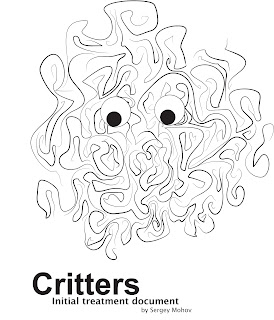Now that I'm finally done with this long and tiresome writing of initial treatment document of Critters, I can talk about fun stuff I had implemented in it and about the very process of writing this document. First of all, what is the initial treatment itself?
I’ve got the idea of writing a portfolio based on these documents from a classic game design book called Game Architecture and Design by Andrew Rollings and Dave Morris (New Riders Publishing). The authors of this book assume that each game needs a first formalized document which will describe its mechanics, interface, graphics, game screens and other stuff. Basically, an initial treatment document is a formalized idea of the game—not a free-form game vision, but not yet a full-scale design document. It ought to give the reader an idea of what the game is supposed to look like by the end of development and help to decide whether or not this game deserves to be developed at all.
You can check out the document at its Google Docs page, so that I don’t have to describe it exhaustively. Instead I would like to focus on the game’s main features and USP’s as well as making clear how the document was written and planned.
Critters is built around one idea—that of an action/RPG based on mounts. It is not extremely different from other action/RPG’s, however, it offers some fresh approach to gameplay. Why move yourself if someone could do it for you? Why cast spells yourself, if your loyal critter will gladly do the job for you? You, on the other hand, will have to find those critters willing to help you, and it is also you who’s job will be to make the critters’ life easier. You control them.
At first I thought that this one mechanic change will not affect this much of the gameplay. I was even thinking of adopting one of existing RP-systems to realities of Critters, when an idea popped into my head—the whole fetish Diablo-like dancing around items and worshiping new enchanted plate mails can be easily replaced in my game. In fact, the inventory itself almost won’t be needed at all. Instead, the whole new perk system should be introduced. Perks can easily replace items if there is a sufficient number of them in the game, not to mention critters themselves, which can be added in great numbers. This way the whole economic model would be reduced to inexistent state and replaced by parts of the RP-system. Therefore, the player will be able to focus on the gameplay and playing the role instead of thinking what to wear and how much gold should be spent on potions.
The next part was making a system which would supply players with new perks and critters. That’s where quests and minigames come in handy. Speaking about quests, I have decided to make rewards dependent on the actions the player does. It is a common approach in self-esteem psychology: each time a first-grader does something that he likes, he gets a compliment exactly for what he has done. This way a player party can complete each quests in up to 10 different ways and each class will get its own reward based on how exactly he acted during this quest. This approach requires some special mechanics and ideas of quests themselves, however, I have composed a few and found out that it seems difficult just for the first 2 or 3 times; then your Blizzardish and BioWarish way of thinking changes and you start thinking variety, which is actually sort of fun.
The same way minigames in Critters require variety. There are two types of them: those for acquiring new critters and competitive ones, which offer a multiplayer- or plot-related challenge. And since there can be up to 4 players in party, it is important to design minigames the appropriate way. In fact, it is quite easy if you start with a singleplayer minigame and then let is evolve and expand, adopting new rules and elements, which would suit different game modes. Obviously, a singleplayer minigame against AI cannot work the same way as a 4 on 4 multiplayer one.
I have introduced two relatively new interface elements into the game: the first being Perk selection and the second—Bestiary. The first one is quite unique mostly because of its intended size and supposed number of minigames in it. The second is basically a spellbook (but a critterbook really) with an important feature in it—each time the player finds information on critter, this information is added in to the Bestiary.
The next fun feature in Critters is the traveling system along with the zone liberation system. Clearly, it was inspired by the game Space Rangers with its captured and free zones. The difference is that in Critters players will be able to travel without predetermined paths like in any MMO game. Making no clear division between zones (also like MMOs) is also a good idea here. Some zones in Critters have their own effects on players’ critters and also influence quests and minigames.
I haven’t really thought about detailed plot yet, but I’m really confident about the setting—dark fairy-tale meets steam-punk medieval. Critters will work best in this kind of setting, not to mention a great variety of unique zones one can think of.
Critters is my second initial treatment document and I could have missed on some important points in it, as well as made some mistakes, so if you decide tor read it, please let me know what you think about it.
Subscribe to:
Post Comments (Atom)


Aaah this is it. I work in a little company, we develop social networks flex applications. Ones I had an game idea, and tried to describe it on a paper, just like in this doc. When I declared all instances of this game I realize that this is too complex game for us now, we haven't enough resources to develop things like that. Whatever, game design it's interesting theme. I start learn computer programming when I was 12 years old just because it was interesting for me, how my lovely Doom II designed within, how it works. Your game design specification is very clear and well done.
ReplyDeleteStay wrighting.
Thank you! I most certainly will :-)
ReplyDelete